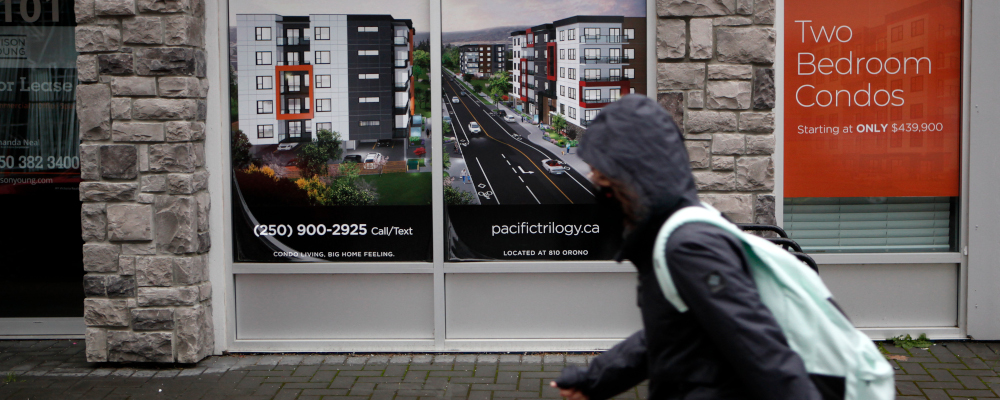If you want a well-functioning economy, people must have hope that hard work will lead to success. But in Canada, people are giving up. A recent poll by Abacus found that a full 74 percent of Canadians believe housing affordability will get worse for first-time homebuyers in 2024 and that 57 percent of non-homeowners are either pretty pessimistic or have given up hope entirely of ever being able to buy a home. That’s up from 48 percent since September 2023.
Locking young people out of home ownership is bad for the political fortunes of incumbent governments and bad for the economy. It is also a threat to the social stability of Canada, according to a recent RCMP report. Therefore, all orders of governments need to restore the dream of homeownership to Millennials and Generation Z, while creating abundant options for renters.
Additional housing supply for both owners and renters is necessary. But building new supply will take time. Governments cannot expect people to feel good about the measures taken to increase housing supply if they’re living in unsuitable spaces, with only the promise that supply may restore affordability in a decade or more. Canadians need solutions now, so the government needs to find ways to get existing homes into the hands of first-time homebuyers.
We believe it’s possible to attack the demand side of the equation to get first-time homebuyers into homes sooner. This goal can be accomplished through a three-part plan of scaling back international student enrollment, creating incentives for investors to return single-family homes to the ownership market, and making it easier for first-time homebuyers to qualify for mortgages. The key is that all of these reforms must be implemented together for it to have an effect.

Getting more single-family homes back into the hands of families
The only immediate way to increase homeownership for younger families is to make it easier for them to buy homes that already exist or are about to be completed. In Ontario alone, there are nearly 700,000 single-detached, semi-detached, and row homes that are not occupied by their owners but are serving some other purpose.
While homes being left unoccupied or turned into short-term rentals receive a great deal of attention, the majority of these investor-owned homes are being used as long-term rentals, often for university and college students. With the international student boom, entire neighbourhoods are getting converted into student rentals. These conversions reduce the number of homes available for families but also cause inefficient use of existing infrastructure. It leaves local elementary schools underused because these neighbourhoods then lack children.
International students and other non-permanent residents add to the social, cultural, and economic fabric of Canada. However, for them to thrive, they must have adequate housing. Canada’s international students and temporary foreign workers programs need to be scaled back even more until Canada’s non-permanent resident population returns to pre-pandemic levels. The scale of the international student program, in particular, should be tied to the construction of on-campus or near-campus housing. This could help prevent the loss of single-family neighbourhoods in our cities.
Governments should then create incentives for the current owners of those student rentals to return them to the market to be used as homes for actual families. A time-limited and temporary reduction in capital gains tax or provincial land-transfer taxes when selling a secondary property could act as such an incentive. For example, the capital gains inclusion rate could be lowered for any single-family home or condo unit purchased before January 1, 2024, so long as that unit is sold to a buyer using it as a primary residence, and the sale is completed between July 1, 2024, and July 1, 2027. This measure would incentivize investors to return those units to the ownership market. Over the longer term, the tax system should be designed to disincentivize investors (from mom-and-pop investors to large domestic and foreign corporations) from buying up existing single-family homes and instead incentivizing them to provide capital only to new home construction (rental and ownership).
While having investors sell their portfolio of single-family homes will increase the supply of homes available for purchase and put downward pressure on prices, it will still likely not be enough to allow first-time buyers to purchase these homes. Last year, home sales dropped by 11 percent due in part to high prices and interest rates, causing first-time homebuyers and young families to be unable to qualify for a mortgage at all. The drop in sales can be addressed by recognizing that the current rules could be better designed for younger homebuyers.
For example, the current 25-year amortization rule helps ensure homebuyers will not still be paying off their mortgages when they are in their 80s or 90s. However, these rules do not take into account the age of the buyer and treat a 50-year-old and a 30-year-old the same. Because younger buyers have more time left in their working careers, they should be allowed to choose longer amortizations if they wish. A 35-year-old buyer with a 30-year amortization would still have their mortgage paid off before retirement. The federal government could create an amortization length of 30 years, but only for first-time homebuyers of primary residences. Ideally, this would only apply if one of the buyers is under 40 years old. It could even introduce 35-year amortizations for buyers under age 35. The reform would allow more young families to qualify for a mortgage and give an advantage to first-time homebuyers when they are competing with investors and older buyers for a home.

Finally, the current stress test rules are not particularly well-designed for young professionals. The stress test is an important tool to ensure that homebuyers can continue making payments if interest rates go up or if economic circumstances change. However, the current test may be excessive for young professionals, who are likely to be earning more five years from now than they are today. Canada should consider reducing the stress test rate from 200 basis points to 50 basis points, but only for first-time homebuyers of primary residences. Or, for buyers under 40 (and the home will be used as a primary residence), who choose a fixed-rate mortgage of five years or more. As with the amortization changes, it would allow more families to qualify for a mortgage, while giving an advantage to families over investors.
It is critical that these ideas be implemented together. Policies designed to increase homeownership that do not take into account the rental market risk displacing renters. A program in the Netherlands that banned investor ownership of some housing types did manage to increase first-time ownership. But it also led to increases in rents, as lower-income renters were displaced by middle-income families. It left more renters chasing fewer rental properties. A plan to scale back international student enrollment until sufficient on-campus and near-campus housing can be built would help minimize this effect, ensuring rents do not skyrocket as rental housing is converted into ownership housing.
Governments cannot afford to wait for new supply to come onto the market to address the dying dream of homeownership in this country. Canadians cannot afford to wait that long. Demand-side policies must be a part of every government’s toolbox in 2024.
Recommended for You

‘Those deficits are almost surely going to rise’: Trevor Tombe on the fiscal challenges facing the Carney government

Chris Spoke and Peter Copeland: Ontario is missing millions of homes. Here’s where the government is failling—and how it can actually make a meaningful difference

Christopher Snook: Is Canada sleepwalking into dystopia?

Matthew Alexandris: The new housing pipeline is dry. Here’s why



